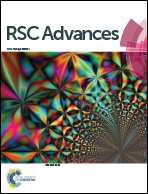All-direction energy harvester based on nano/micro fibers as flexible and stretchable sensors for human motion detection†
Abstract
Highly flexible smart sensors for monitoring human body motion, physiologically and biomechanically, play a paramount role for personalized healthcare. Unlike conventional silicon based devices, stretchable electronic materials are particularly desirable. Here, we demonstrated a nano/micro fibers (NMFs) based generator via a simple, cost effective method by using direct-write, near-field electrospinning (NFES) technique and polyvinylidene fluoride (PVDF) NMFs as source materials. The novelty of this paper is to propose the novel electrode configuration and device layout such that the mechanical deformation from all directions can be harvested and validated experimentally. Unlike the traditional energy harvesters can only harvest energy in a certain movement, the unique characteristic of our device shows a great potential in sustainably scavenging tiny motion without any restriction. The maximum output voltage from the four-layer stacked power generators (PGs) with serial connections reached 20 V, and the maximum output current from the parallel integration can exceed 110 nA. The PVDF NMFs was firmly glued on the skin to detect and harvest the wrist joint movement and the output voltage was ∼1 and ∼0.8 V under the wrist bending and torsional motion respectively. We believe the novel structure of our NMFs-based device is promising in the field of wearable electronics and eventually achieve all-direction flexible energy harvester with very little obstruction.


 Please wait while we load your content...
Please wait while we load your content...